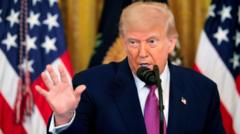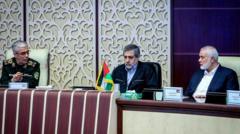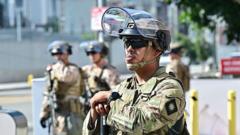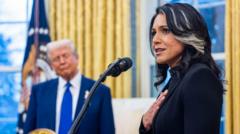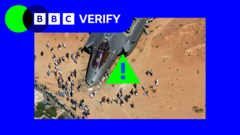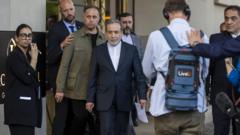The U.S. has struck three Iranian nuclear sites in a significant escalation of military involvement. Analysts warn of potential retaliatory responses from Iran, signaling a critical turn in regional conflict.**
U.S. Involvement in Iran Conflict Escalates with Strategic Strikes on Nuclear Sites**

U.S. Involvement in Iran Conflict Escalates with Strategic Strikes on Nuclear Sites**
President Trump authorizes military action against key Iranian nuclear facilities, raising stakes in the ongoing conflict with Tehran.**
As of June 22, 2025, tensions in the Middle East have surged as the United States officially engaged militarily in the ongoing conflict between Israel and Iran. President Trump announced late Saturday that U.S. bombers successfully targeted three strategic nuclear facilities in Iran, including the notorious underground site at Fordo, a key player in Iran's nuclear ambitions.
Trump's declaration arrives after days of intensifying hostilities, beginning with Israeli airstrikes on Iranian military infrastructure that commenced on June 13. On Saturday, U.S. forces reportedly dropped bombs on Fordo and two additional nuclear sites, marking a notable shift in the U.S. military's posture. As of Sunday morning local time in Iran, Trump confirmed that all aircraft returned safely after executing targeted strikes aimed at crippling Iran's nuclear capabilities.
The attack has stirred significant concern among analysts and regional observers who warn that Iran is likely to retaliate, especially as the strikes represent a major escalation after a period of restraint. Analysts suggest that Iran could react by intensifying its nuclear program or conducting missile assaults on U.S. military positions in the Middle East in response to the American involvement.
While the U.S. has long maintained a stance against Iran's nuclear activities, Trump's previous reluctance to engage directly in the conflict marked a shift in strategy. In the lead-up to the strikes, Secretary of State Marco Rubio emphasized the protection of American assets in the region, suggesting that the administration was reassessing its involvement.
As Trump positioned the U.S. to address the perceived threat of Iranian nuclear weapons, he publicly urged Iranian leadership to comply with demands for "complete surrender." However, once viewed as unlikely, the prospect of Iran accelerating its nuclear developments seems imminent as Tehran grapples with the aftermath of the strikes. Both Iranian officials and military analysts have expressed suspicions that there may be undisclosed nuclear facilities within Iran, potentially bolstering efforts to regain lost ground.
In conjunction with U.S. airstrikes, Israeli forces continued operations against Iranian targets, reportedly killing several high-ranking officials within Iran’s Quds Force, the unit tasked with coordinating regional militia operations. These developments, alongside ongoing regional tensions and diplomatic inertia, paint a complex portrait of a region on the brink of wider conflict—a situation that may indeed redefine Middle Eastern geopolitics in the coming months.
As the world observes this evolving situation, the potential ramifications of U.S. military action in Iran could set the stage for far-reaching consequences that might echo throughout the international community.




